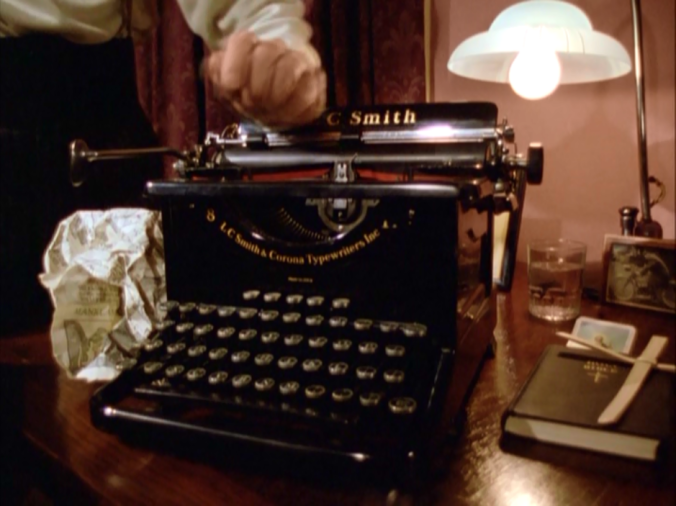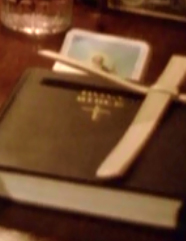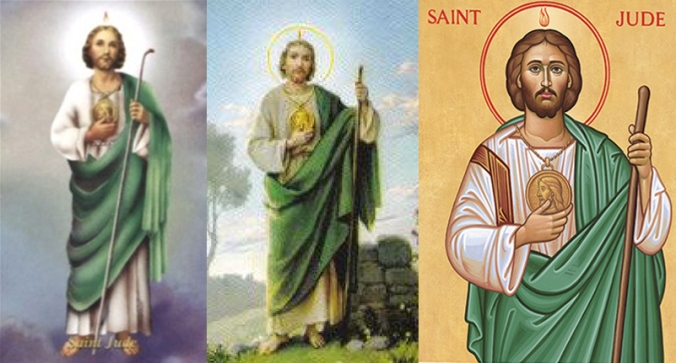In a previous post entitled “The theology of the Clapham Cook,” I discussed some interesting script choices in that first episode; namely, that a passage of Scripture is read by a background character which actually encapsulates the entire theme of the episode. Something similar happens in the television adaptation of The A.B.C. Murders, coupled with a few religious artifacts of note.
Those interested in fashion particularly notice the amazing wardrobe skills on display in a series like Poirot; car enthusiasts are apt to point out the vintage cars. Well, art and theology are two special hobbies of mine, and they inevitably jump out at me in viewings of the show. Sometimes this takes the form of vintage devotional items, which I always notice with great interest, and there happen to be some in this episode.
There is a flashback scene in the denouement in which Cust is receiving his new typewriter. Sitting on his little table are a few personal objects and knick-knacks, including three devotional items: a Bible, a palm cross, and what looks like a little picture or prayer card.
A Bible shows up at least twice more around Cust: in his Doncaster hotel room, and in the prison cell, where he is reading it. (More on that later.) The palm cross is an interesting prop choice– it is a simple, traditional Lenten and Easter craft made from a folded blade of palm frond, sometimes from the palms used on Palm Sunday. It is a symbol of suffering, martyrdom, and future glory. It initially stood out to me because the scene takes place at a different time of year than you’d usually see palm crosses about.
The prayer card or picture is just barely visible, but due to the universal iconography of the figure, I am about 99% sure that there is a picture of St. Jude on it. That particular apostle has for many years, and certainly by the 1930s, been depicted in a white robe with a green drape over one shoulder, holding a staff or club (referencing his martyrdom), having a small flame over his head, and holding an image of Christ. The last two objects are indeterminate in the shot, but the rest are clearly visible. Compare for yourself, intrepid blog reader, whether the card in the shot above is likely to be a picture of St. Jude…
“Fine, well spotted, but who cares?” you say.
It’s merely the interesting coincidence that a glance through the hagiography of St. Jude happens to show some unusual points of connection with A.B. Cust. The Catholic Church represents him as the patron saint of lost causes, things despaired of, and hopeless cases. That association has to do with the fact that St. Jude (or Judas) shares the name of another apostle, Judas Iscariot, the traitor to Jesus. The unfortunate similarity of name, and the subsequent oft-mistaken identity, apparently resulted in a sort of neglect and forgetting of St. Jude by many in the Church, and so he is regarded as a beacon of hope for things despaired of and forgotten. Does that does not ring a bell with the pitiful, forgotten, hapless Mr. Cust– who is not, in fact, the A.B.C. letter-writer, but is presented as the murderer to the police in a case of mistaken identity?
But wait, there’s more. 😉
In his prison cell, just as Poirot enters, we can hear Cust reading from the Bible– to be specific, the Beatitudes, from the Gospel of Matthew, chapter 5. “And He taught them, saying: ‘Blessed are the poor in spirit, for theirs is the kingdom of heaven. Blessed are they that mourn, for they shall be comforted. Blessed are the meek, for they shall inherit–”
The Beatitudes are a well-known Christian text that offer words of comfort and blessing by Christ to the suffering, wrongly oppressed and accused, and persecuted. Again, this fits Cust to a tee, and the reading here at least was certainly not coincidental, but chosen for that purpose.
But in other interesting details of chance: the staff or club held by St. Jude signifies that he was martyred by being bludgeoned to death, which is how the murderer commits two of his deeds, including the “main” murder of his brother. And also, take notice where Cust suddenly stops in his reading. “For they shall inherit…” Unknowingly, Cust utters the real motive for the crime of which he is unjustly accused– Franklin Clarke kills in order to inherit his brother’s fortune!
“’Course, it might be a coincidence.”
Oh, who am I kidding, of course I do! 😉
I don’t pretend that the particular choice of devotional items was intentional, in those particulars, for the episode, but how very well it all hangs together, n’est-ce pas?





Very well spotted. I think I’ll watch that episode today. I never noticed. You’re very observant. Keep up the good work
LikeLike
Thanks!
LikeLike
It is awsome thank you! 🙂
LikeLike